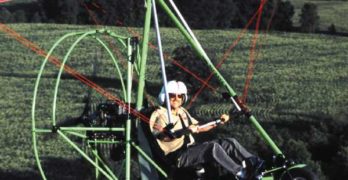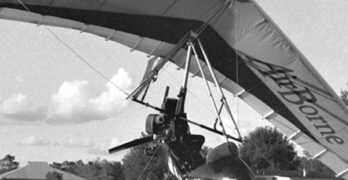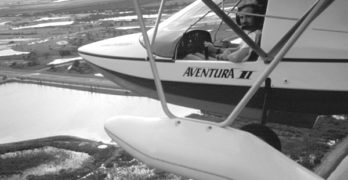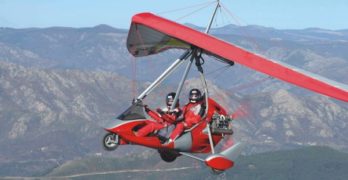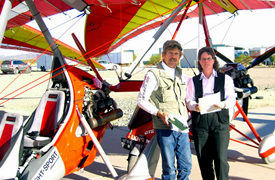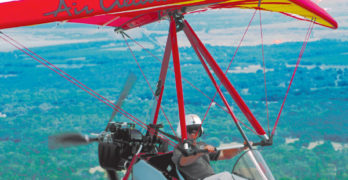I never really noticed before just how much the Buckeye Industries powered parachute carriage looked like a trike carriage. Maybe you didn’t either, but in your mind’s eye, remove the prop guard and see if you don’t agree. They aren’t identical, of course, but the visual relationship is uncannily close considering the two aircraft types developed separately.
What a perfect situation. Ralph Howard’s family members and friends have built Buckeye from “nothing” to one of the world’s largest aircraft manufacturers, all in the ’90s and without even using the entire decade! Whatever combination of talent, money, timing and luck was involved in this tale of success, the Howards want to keep it going strong. That won’t be easy, but these Indiana Hoosiers may be up to the task.
Take the momentum of a reported several hundred powered parachute units sold each of the last few years. Revise the hardware slightly to expand into the manufacture of trikes, and you have a potent mixture that could emerge as one of America’s largest trike builders.
Search Results for : CT AND hand control
Not finding exactly what you expected? Try our advanced search option.
Select a manufacturer to go straight to all our content about that manufacturer.
Select an aircraft model to go straight to all our content about that model.
The AirBorne Edge
AirBorne Windsports is no johnny-come-lately to the ultralight flying scene. The Australian company has been making hang gliders for the international market for years. AirBorne’s owners – Russ and Rick Duncan – once flew for Moyes Delta Pty., another Australian hang glider company (now known for its Moyes-Bailey Dragonfly aerotug), but later branched out on their own.
While both men are thirty-somethings today, they have long experience, starting with competition in hang gliders back when folks still called them “the little Duncan brothers.” They were hot pilots at a young age. Later on, they proved to be solid competitors to the Moyes juggernaut.
Then Came Trikes
A divergence occurred. After linking up with Florida designer Bobby Bailey to produce the 3-axis Dragonfly aerotug, Moyes’s interest in trikes fell by the wayside. They focused on the already popular Dragonfly for their towing promotion.
Meanwhile, the Duncans – now on their own, producing hang gliders – engaged in building trikes.
Aventura II
If you’ve never flown an airplane on floats, you’ve missed a glorious experience in flying. Good as any ultralight on floats may be – and that means “quite excellent” in my opinion – even those pilots with that experience may have missed the unique sensation of a boat-hulled ultralight.
With a few thousand hours in my logbook covering everything from foot-launched hang gliders to twin-engined Barons, I can honestly say my absolute favorite hours are spent in one of two ways: first is soaring flight, but a close second is warm summer day flying in an ultralight floatplane.
It just doesn’t get any better.
Having stuck my personal opinion into this article, I must tell you about a most promising company and their 2-seat floatplane, the Aventura II. Since Arnet Pereyra exploded into the ultralight scene in 1995, this new company has filled out their line of floatplanes with a roomy and fun 2-seater which deserves a close look.
Eye On the Sky Watch
There was a time when a company called Beaver RX Enterprises – which produced the Canadian Beaver designs – was among the leading North American ultralight manufacturers.
In particular, the Beaver 550 tandem 2-seater attracted many customers. The company once claimed more than 3,500 ultralights flying. Certainly the model dominated the western Canadian market but also had a presence in the U.S. and other countries.
The old Beaver RX Enterprises company went through a number of leadership changes and, driven by overly-ambitious management goals, finally succumbed.
When I visited the now defunct company, the firm was a publicly-held corporation listed on the Vancouver Stock Exchange. Even the stock exchange has experienced a transformation, so perhaps it isn’t surprising that Beaver RX Enterprises also lost its heading.
As we’ve seen with other good designs, however – such as Quicksilvers, Phantoms or Drifters – the better ultralights can outlast their ownership. The Beaver line is among those survivors.
High-end, High-energy Alternative
On the horizon
Air Creation’s new TanarG is a high-end, high-energy alternative.
Thanks to aviation pioneers in France, Americans use terms such as empennage, aileron and fuselage. For 2005, we can learn a new French word: TanarG. This is the name of a new aircraft from Air Creation, the world’s largest trike builder. And based on a first review, this is the slickest rig from the company to date.
At first glance, the TanarG Air Recreational Vehicle (it’s a trike) may appear like the company’s Clipper model, but look more carefully. This new chassis has so many changes that up close, it bears little resemblance to earlier models.
What’s In a Name?
When I first heard from John Kemmeries of Air Creation USA, he said that the term tanarg “is an ancient word meaning a strong natural force, such as a tsunami.” Given last January’s earthquake in the Indian Ocean and the subsequent disaster, tsunami takes on new meaning.
State of the Art in Hang Gliding
In the last 10 years there have been significant developments in hang glider wings. That may come as a surprise to KITPLANES® readers. After all, the wings don’t look much different from one another, so the changes must be subtle, right?
Well, yes and no. In fact, many subtle changes have occurred as these wings have steadily progressed from a glide angle of 4:1 in the 1970s to the 15:1 glides that are common today. Even as they gained efficiency, the wings haven’t changed a lot in appearance.
But not all of the changes are so subtle. The ATOS VX I flew in late 2004 illustrates a radically different approach to wing design. The ATOS VX can achieve a glide angle of 20:1 and a sink rate of only 118 fpm. The latter number makes this wing competitive with many sailplanes, even though the pilot hangs in the airstream.
An Innovative Design
The design is produced by Aeronautic Innovation Rühle (AIR) and is the creation of Felix Rühle, who worked with composite materials for many years in his role with the German government’s Center for Research and Development in Aerospace Technology in Stuttgart.
Fk-9 Mark III
Sleek composite microlight performs like a GA aircraft In the Dec. 11 Flyer, I wrote about the Albatros, which I call a hybrid ultralight because it bridges older tube-and-rag ultralights and new all-composite models.
This month we look at the German-built FK-9 from B&F Technik. A new breed with an interesting history, it too emerged from an earlier design. In fact, the FK-9 shown in photos that accompany this story is the glass-fiber Mark 3. Its predecessors, the Mark 1 and Mark 2, used fabric skins, putting them more in the hybrid category.
To review briefly, hybrid microlights are flying machines that employ the best ideas of familiar ultralight designs, such as sewn Dacron wings and aluminum airframes, yet combine those proven components with composite fuselages and welded steel parts. Simple construction keeps many small builders in business.
Conversely, the composite microlights are typically all-composite designs (or composite over steel) using newer construction technology and techniques.
Tom Ivicevich’s Wright Flyer
The Wrightness of one man’s dream
On December 17, 2003, Tom Ivicevich’s Wright Flyer won’t represent the only attempt to recreate the brothers’ famous accomplishment. Nor will he be the only Wright pilot flying cross-country to arrive at the sand dune shrine in Kitty Hawk, North Carolina. But Ivicevich will do it all without major sponsorships. And he intends to fly coast to coast in his enhanced version of the original Wright Flyer.
This is one man’s dream, and he is well underway to reaching his goal.
Creating Interest
In January this year, Ivicevich’s 5¼8-scale Flyer flew while being towed by a 1930 Model A pickup truck at Redding Municipal Airport in California. The 190-pound aircraft took readily to the air at 25 mph.
In February, Ivicevich announced, “I am now organizing the start of construction for the full-size Flyer.” Next year, he plans to launch from Torrance, California, and make his way across the country.
Air Creation Earns First Trike SLSA Certificates
Air Creation’s magnificent Tanarg 912 and their popular GTE 912 were presented with the first two weight shift control Special Light-Sport Aircraft certificates on January 20th in Arizona at Kemmeries Aviation flight center where Air Creation USA is based. Not only are these the first two certificates ever issued for weight shift control LSA, the Tanarg 912 and GTE 912 were approved with the iXess, iXess Training, KISS 450, and FUN 450 wings. None of the 24 airplane SLSA holders can make that claim of versatility. (If you don’t know this quality of trikes…the chassis or carriage can be flown with a variety of factory-approved wings.) Air Creation has delivered more trike aircraft than any other builder. This French company is 20% owned by American John Kemmeries, an icon and leader of weight shift aircraft in the United States.
Air Creation Buggy/Kiss
For many years, I’ve been critical of trike handling. While I try never to forecast the future, I’ve gone out on a limb and predicted that rigid-wings will eventually become commonplace on trikes (though I don’t also predict delta wings will disappear).
Going Rigid?
Rigid-wings look a lot like modern hang gliders and trike wings in many ways, but they have control surfaces. Because these surfaces are deployed via weight-shift movements they neatly combine the benefits of 3-axis ultralights – lower control forces and good control authority – with the elegant simplicity of weight-shift. Rigid-wings can carry good weight and are somewhat faster than delta wings (called “flex wings” by hang glider pilots), and they also handle more easily. I think this makes them a nearly inevitable development.
While I still believe rigid-wings are coming to trikes, it may take longer than I thought because the trike industry may finally be rising to the challenge.
- « Previous Page
- 1
- …
- 46
- 47
- 48
- 49
- 50
- …
- 61
- Next Page »


